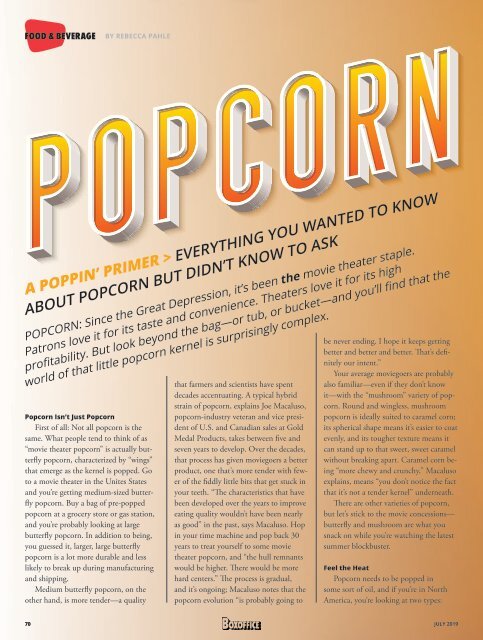Boxoffice - July 2019
The Official Magazine of the National Association of Theatre Owners
The Official Magazine of the National Association of Theatre Owners
You also want an ePaper? Increase the reach of your titles
YUMPU automatically turns print PDFs into web optimized ePapers that Google loves.
FOOD & BEVERAGE<br />
BY REBECCA PAHLE<br />
A POPPIN’ PRIMER > EVERYTHING YOU WANTED TO KNOW<br />
ABOUT POPCORN BUT DIDN’T KNOW TO ASK<br />
POPCORN: Since the Great Depression, it’s been the movie theater staple.<br />
Patrons love it for its taste and convenience. Theaters love it for its high<br />
profitability. But look beyond the bag—or tub, or bucket—and you’ll find that the<br />
world of that little popcorn kernel is surprisingly complex.<br />
Popcorn Isn’t Just Popcorn<br />
First of all: Not all popcorn is the<br />
same. What people tend to think of as<br />
“movie theater popcorn” is actually butterfly<br />
popcorn, characterized by “wings”<br />
that emerge as the kernel is popped. Go<br />
to a movie theater in the Unites States<br />
and you’re getting medium-sized butterfly<br />
popcorn. Buy a bag of pre-popped<br />
popcorn at a grocery store or gas station,<br />
and you’re probably looking at large<br />
butterfly popcorn. In addition to being,<br />
you guessed it, larger, large butterfly<br />
popcorn is a lot more durable and less<br />
likely to break up during manufacturing<br />
and shipping.<br />
Medium butterfly popcorn, on the<br />
other hand, is more tender—a quality<br />
that farmers and scientists have spent<br />
decades accentuating. A typical hybrid<br />
strain of popcorn, explains Joe Macaluso,<br />
popcorn-industry veteran and vice president<br />
of U.S. and Canadian sales at Gold<br />
Medal Products, takes between five and<br />
seven years to develop. Over the decades,<br />
that process has given moviegoers a better<br />
product, one that’s more tender with fewer<br />
of the fiddly little bits that get stuck in<br />
your teeth. “The characteristics that have<br />
been developed over the years to improve<br />
eating quality wouldn’t have been nearly<br />
as good” in the past, says Macaluso. Hop<br />
in your time machine and pop back 30<br />
years to treat yourself to some movie<br />
theater popcorn, and “the hull remnants<br />
would be higher. There would be more<br />
hard centers.” The process is gradual,<br />
and it’s ongoing; Macaluso notes that the<br />
popcorn evolution “is probably going to<br />
be never ending. I hope it keeps getting<br />
better and better and better. That’s definitely<br />
our intent.”<br />
Your average moviegoers are probably<br />
also familiar—even if they don’t know<br />
it—with the “mushroom” variety of popcorn.<br />
Round and wingless, mushroom<br />
popcorn is ideally suited to caramel corn;<br />
its spherical shape means it’s easier to coat<br />
evenly, and its tougher texture means it<br />
can stand up to that sweet, sweet caramel<br />
without breaking apart. Caramel corn being<br />
“more chewy and crunchy,” Macaluso<br />
explains, means “you don’t notice the fact<br />
that it’s not a tender kernel” underneath.<br />
There are other varieties of popcorn,<br />
but let’s stick to the movie concessions—<br />
butterfly and mushroom are what you<br />
snack on while you’re watching the latest<br />
summer blockbuster.<br />
Feel the Heat<br />
Popcorn needs to be popped in<br />
some sort of oil, and if you’re in North<br />
America, you’re looking at two types:<br />
70 JULY <strong>2019</strong>

















